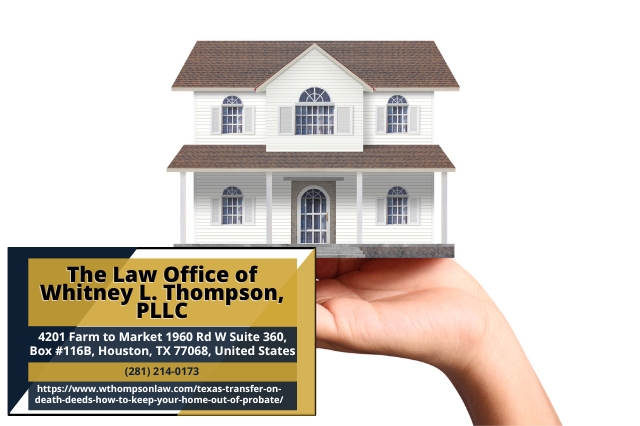Planning ahead can make a significant difference when it comes to protecting your home and easing the burden on your loved ones. In Texas, a Transfer-on-Death Deed (TODD) offers a straightforward way to pass real estate to chosen beneficiaries without going through probate. This legal tool can simplify the transfer of property after death, reduce costs, and avoid delays that often come with court proceedings.
However, using a TODD requires careful attention to legal requirements and personal circumstances. If you’re considering this option, speaking with an experienced probate attorney can help you determine whether a Transfer-on-Death Deed is the right fit for your estate plan. At The Law Office of Whitney L. Thompson, our team of Houston probate lawyers may be able to assist you with preparing, reviewing, and recording TODDs, while also exploring alternative strategies tailored to your goals. Contact us today at (281) 214-0173 to schedule a consultation.
What is Probate and Why Would You Want to Avoid It in Texas?
Probate is the legal process through which a deceased person’s estate is administered. If the decedent had a valid Will, the probate court validates the Will, appoints an executor, and oversees the executor’s duties, which include inventorying assets, paying debts and taxes, and ultimately distributing the remaining property to the beneficiaries named in the Will. If there is no Will (a situation known as dying “intestate”), the court will determine heirs according to Texas law and appoint an administrator to manage the estate.
Some individuals seek to avoid probate for several reasons:
- Costs: Probate can be expensive. Attorney fees, executor fees (if applicable), court costs, and appraisal fees can accumulate, potentially consuming 3-5% or more of the estate’s total value. These costs reduce the assets ultimately passing to beneficiaries.
- Delays: The probate process is not immediate. In Texas, the average probate proceeding takes between six to twelve months, and complicated estates can drag on for much longer. This delay can be frustrating for heirs waiting to receive their inheritance.
- Lack of Privacy: Probate proceedings and documents are generally public records. This means that details about the deceased’s assets, debts, and the identity of beneficiaries become accessible to anyone who wishes to look them up, which is a concern for families who value privacy.
- Stress and Burden on Family: Going through the legal system, especially during a time of grief, can be emotionally taxing and administratively burdensome for the surviving family members tasked with managing the estate.
Thoughtful planning now lets your estate transfer through mechanisms that operate outside the probate court, freeing loved ones to move forward without added legal procedures.

How Do Texas Transfer-on-Death Deeds (TODD) Work
A Texas Transfer-on-Death Deed, or TODD, offers property owners a way to transfer real estate to chosen beneficiaries without going through probate. Enacted under the Texas Real Property Transfer on Death Act and codified in Chapter 114 of the Texas Estates Code, this legal tool simplifies estate planning for real property.
The TODD allows a property owner, known as the transferor, to name beneficiaries who will receive the property upon the owner’s death. The deed must be signed and recorded during the owner’s lifetime, but it has no legal effect until the owner passes away. While still living, the owner retains full control over the property and may sell, lease, or mortgage it at will. Beneficiaries have no ownership rights or claims while the owner is alive, and the property is protected from their creditors.
When the transferor dies, ownership of the property automatically passes to the named beneficiaries. This bypasses probate, keeping the property out of the deceased’s estate and simplifying the transition.
What are the Requirements for a Valid Transfer-on-Death Deed in Texas?
To be valid under Texas law, a TODD must satisfy several requirements:
- In Writing, Signed, and Notarized: The deed must be in writing, signed by the owner, and acknowledged before a notary public.
- Legal Description of the Property: It must include an accurate legal description, ideally taken from an existing deed rather than a tax record.
- Beneficiary Designation: The deed must clearly identify one or more beneficiaries by name and address.
- Statement of Transfer at Death: The document must specify that the transfer is to occur at the owner’s death.
- Recorded Before Owner’s Death: The TODD must be recorded in the official records of the county where the property is located before the owner’s death. A TODD not recorded in time is legally void.
- Owner’s Competency: The transferor must be mentally competent at the time of signing. A TODD cannot be executed by someone acting under a Power of Attorney.
Failing to meet any of these requirements may render the Transfer-on-Death Deed invalid, meaning the property could still go through probate. The inability to use a Power of Attorney for creating a TODD highlights the importance of proactive estate planning, especially for those who may face capacity issues in the future.
| Requirement | Details |
|---|---|
| Written, Signed, Notarized | The deed must be in writing, signed by the owner, and notarized. |
| Legal Property Description | Must include a precise legal description, preferably from an existing deed—not a tax record. |
| Named Beneficiary | One or more beneficiaries must be clearly identified by name and address. |
| Death Transfer Statement | The document must state the property transfers upon the owner’s death. |
| Recorded Timely | Must be recorded in the county’s official records before the owner’s death to be valid. |
| Owner’s Mental Competency | The transferor must be competent at the time of signing; a Power of Attorney cannot be used. |
Advantages of Using a Transfer-on-Death Deed for Your Home
Transfer-on-Death Deeds have become a popular estate planning option for Texas homeowners seeking an efficient, cost-effective way to pass on real property. These deeds provide several important benefits that can simplify the transfer of a home after death.
Avoiding Probate for Your Home
The most significant advantage of using a TODD is the ability to transfer ownership of a home outside the probate process. This direct transfer avoids the delays, expenses, and public nature of probate court. Beneficiaries receive title to the property more quickly and with fewer legal hurdles, making the transition smoother at a time when families are often experiencing grief and administrative burdens.
Retained Owner Control
A Transfer-on-Death Deed allows homeowners to retain complete control of their property while they are alive. Signing and recording it does not limit the owner’s rights to live in the home, sell it, refinance, lease, or encumber the property. The designated beneficiaries have no legal claim to the home during the owner’s lifetime, and their financial obligations or liabilities do not affect the property. This level of control helps homeowners plan for the future without giving up current autonomy.
Simplicity (on the Surface)
Compared to other estate planning tools such as revocable living trusts, a TODD appears simple and accessible. The statutory requirements are clear, and the process does not generally require court involvement or trust administration. For many, this makes a Transfer-on-Death Deed an attractive option for transferring a primary residence or other real estate. However, while the process may seem straightforward, it can present challenges if the deed is not carefully drafted or if the broader estate plan is not aligned with the TODD.
Potential Medicaid Estate Recovery Program (MERP) Protection
A lesser-known advantage of the TODD is its potential impact on Medicaid estate recovery. In Texas, the Medicaid Estate Recovery Program typically seeks reimbursement only from probate assets. Because a Transfer-on-Death Deed transfers property outside of probate, the home may fall outside the reach of MERP claims. This can be beneficial for Medicaid recipients who want to preserve the value of their home for loved ones.
However, Medicaid laws and policies are complicated and subject to revision. Using a TODD as part of a Medicaid strategy should only be done with guidance from an experienced attorney, as missteps could result in unintended financial exposure or disqualification from benefits.
Creating and Recording a Transfer-on-Death Deed in Texas
Executing a valid Transfer-on-Death Deed in Texas involves more than just completing a form. Each step must be performed precisely to comply with statutory requirements. Even small errors in the process can render the deed invalid, preventing the intended transfer and potentially sending the property through probate.
Drafting the Deed
The TODD must include all elements required by Texas law to be enforceable:
- The deed must identify the property owner (transferor) and clearly name the designated beneficiary or beneficiaries, along with their addresses.
- It must contain the full legal description of the real property. This description should be copied directly from an existing deed, not from appraisal district records, which may contain inaccuracies.
- The deed must state that the transfer to the beneficiary will take effect upon the transferor’s death.
- Property owners may name both primary and alternate (contingent) beneficiaries. If a primary beneficiary does not survive the owner, the contingent beneficiary can inherit the property.
- If multiple beneficiaries are named to inherit simultaneously, they generally receive equal, undivided shares as tenants in common unless the deed provides otherwise.
Signing and Notarization
Once the TODD is properly drafted, the property owner must sign it in front of a notary public. The notary’s role is to confirm the identity of the signer and witness the execution of the document. Without notarization, the deed does not meet the legal requirements and will not be valid.
Recording the TODD
The deed must be recorded in the official public records of the county where the property is located, and this must occur before the property owner’s death. This timing is critical. If the TODD is signed and notarized but not recorded while the owner is still living, it becomes void and will not transfer the property as intended.
A recording fee will apply, which is paid to the County Clerk at the time of filing. Once properly recorded, the deed becomes part of the public record.
Revoking or Amending a Transfer-on-Death Deed
One of the advantages of a Texas Transfer-on-Death Deed is its flexibility. A property owner who creates a TODD retains the right to revoke or amend it at any time during their lifetime, provided they remain mentally competent. Because beneficiaries do not have a vested interest in the property until the owner’s death, their consent is not required for changes or revocation. This feature gives property owners the ability to adapt their estate plans if circumstances change, such as new relationships, the passing of a named beneficiary, or a shift in financial priorities.
Revoking a TODD
Texas law provides two primary ways to revoke a previously recorded TODD:
- Record a New TODD: A property owner may create and record a new Transfer-on-Death Deed for the same property. If the new deed expressly revokes the prior TODD, or if it includes terms inconsistent with the original, such as naming different beneficiaries, it will override the previous deed or the inconsistent provisions. This method allows the owner to update the deed without needing to first cancel the existing one.
- Record an Instrument of Revocation: An owner may also execute and record a formal document, often titled “Instrument of Revocation” or “Cancellation of Transfer on Death Deed”—that clearly states the intention to revoke the earlier TODD. This approach is especially useful if the owner wants to remove the TODD altogether without replacing it with a new one.
To be effective, either the new TODD or the Instrument of Revocation must be signed by the owner, notarized, and recorded in the county where the property is located before the owner’s death. Failure to follow these steps means the revocation will not take legal effect, and the previously recorded TODD will still control the property’s transfer.
Revocation by Sale or Transfer
If the owner sells or otherwise conveys the property through a standard deed during their lifetime (such as a General Warranty Deed), that act automatically cancels any previously recorded Transfer-on-Death Deed associated with the property. In this case, no additional revocation document is required. This automatic revocation recognizes that once the owner no longer owns the property, there is nothing left to transfer through the TODD.
A Will Cannot Revoke a TODD
A common misconception is that a provision in a Last Will and Testament can override a TODD. This is not the case. A will does not revoke a recorded Transfer-on-Death Deed, even if it names a different beneficiary for the same property. Any changes to the distribution of real property subject to a TODD must be made through one of the formal revocation methods provided by statute. Relying on a will to override a TODD can lead to confusion, legal disputes among heirs, and unintended outcomes during the estate settlement process.
While a TODD provides flexibility in estate planning, changes to it require the same formalities as its creation—proper execution, notarization, and timely recording. Property owners should review their TODD periodically and update or revoke it if their goals or relationships change. Taking the time to make these adjustments properly can help avoid uncertainty and protect the owner’s final wishes.
Is a TODD Always the Best Choice? When to Consider Alternatives
While a Transfer-on-Death Deed can be a useful estate planning tool for avoiding probate on a primary residence, it is not always the best fit for every situation. In some cases, other legal instruments may offer better protection, more flexibility, or a clearer path to achieving long-term estate planning goals.
Complex Family Dynamics
A TODD may fall short in families where dynamics are complicated, such as blended families, unequal inheritance plans, or potential disputes among heirs. In these cases, a Revocable Living Trust offers greater control and clarity. It allows the property owner to set detailed instructions for distribution, stagger inheritances, or impose conditions that help reduce conflict and protect family relationships.
Significant Debts
If the property owner dies with substantial debt, the protection a TODD offers may be limited. Although a TODD avoids probate, creditors can still pursue claims against the transferred property for up to two years if the probate estate lacks sufficient assets to cover outstanding obligations. This means the benefit of bypassing probate may be undermined if the home becomes subject to debt recovery.
Need for Incapacity Planning
One of the key limitations of a TODD is that it cannot be created, changed, or revoked by someone acting under a Power of Attorney. If the owner becomes incapacitated without having previously updated or revoked the TODD, no further changes can be made. In contrast, a Revocable Living Trust allows a successor trustee to step in and manage trust property during periods of incapacity. Similarly, a Lady Bird Deed, which retains enhanced life estate rights, can sometimes be modified by an authorized agent under a properly drafted POA, making it a more flexible option in these scenarios.
Asset Protection for Beneficiaries
If the goal is to shield the inherited property from a beneficiary’s creditors, potential divorce proceedings, or financial mismanagement, a TODD offers limited protection. Trust-based planning, whether through a Revocable Living Trust or a testamentary trust created in a Will, can be tailored to protect beneficiaries while preserving the long-term value of the inheritance. This is especially important for minor children, spendthrift heirs, or beneficiaries with special needs.
Multiple Properties or Diverse Assets
A TODD is generally limited to a single piece of real estate. For individuals with multiple properties or a range of assets, such as investment accounts, business interests, or out-of-state real estate, a Revocable Living Trust offers a more comprehensive solution. It consolidates management and distribution of the estate in a single plan, avoiding the need for multiple probate proceedings or inconsistent beneficiary designations.
Concerns about Title Issues or Warranties
Texas TODDs transfer property without any warranty of title. This can raise issues if beneficiaries later wish to sell the property and face questions about ownership or undisclosed encumbrances. If delivering a clear title is a high priority, other tools such as a Lady Bird Deed or a transfer through a trust with warranty provisions may be more appropriate.
Speak With an Experienced Houston Probate Lawyer Today
A Texas Transfer-on-Death Deed can be a powerful tool for avoiding probate and simplifying the transfer of your home, but it must be executed properly and used in the right context. Whether you’re planning for the future or reevaluating your current estate documents, it’s important to understand how a TODD fits into your broader goals.
At The Law Office of Whitney L. Thompson, we help clients throughout Houston create estate plans that reflect their needs and protect what matters most. Our team can walk you through the requirements of a TODD, identify any potential risks, and offer tailored solutions that align with your circumstances. Contact us today at (281) 214-0173 to discuss how we may assist you.







